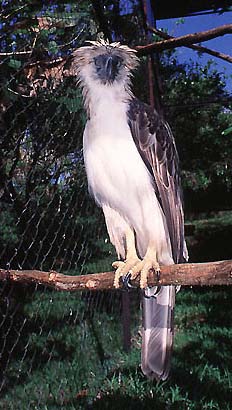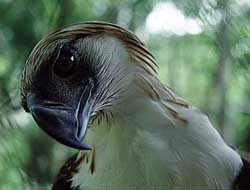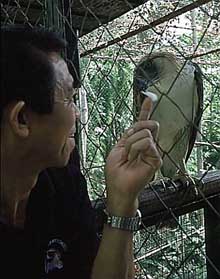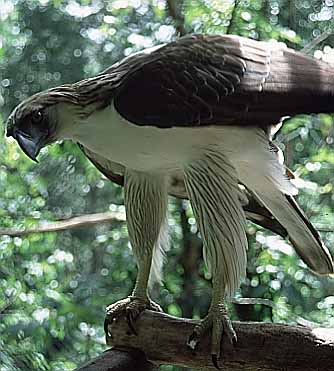一個人的堅持為極度瀕危的猛禽帶來了希望
在菲律賓南部棉蘭老島上一個溫暖、陽光明媚的早晨,多明哥·塔德納站在一個寬敞的籠子旁的金屬平台上,看著一隻雄性菲律賓鷹 傑氏食猿 準備吃一隻小雞。這隻巨大而高貴的鳥用幾乎與塔德納伸出的雙手一樣大的爪子抓住了食物。它彎著腰,低下頭,用鋒利的喙從死雞身上撕下一塊肉。
多明哥‧塔德納 (Domingo Tadena) 55 歲,身材瘦削,臉上飽經風霜,對這種鳥並不陌生。 Pag-Asa(他加祿語的意思是「希望」)是在菲律賓鷹中心飼養的第一隻菲律賓鷹,該中心是阿波山山腳下一個佔地八公頃的營地。
該中心致力於拯救這個極度瀕危物種,飼養 23 隻老鷹和雛鳥,擁有 15 名員工。 「這些鷹對我來說就像家人一樣,」塔德納說,他是該中心圈養繁殖計劃的負責人,並稱這種鳥為「森林之王」。
宏偉的菲律賓鷹

描述很貼切。菲律賓鷹是最大的鷹之一,翼展長達兩米,是世界上最華麗的猛禽之一。美國著名飛行員查爾斯·林德伯格 (Charles Lindbergh) 於 1969 年幫助制定了一項保護它的計劃,稱其為“最高尚的飛行員”。
菲律賓雕原產於四個島嶼,近幾十年來,其數量急劇下降,主要原因是狩獵和森林砍伐。最近的估計顯示,野外的總數量為 340 對,其中棉蘭老島是現存數量最多的地區。塔德納將大部分工作時間都奉獻給了菲律賓鷹,他希望透過將圈養的鳥類重新引入野外來確保其生存。
他對鳥類的熱愛可以追溯到他的童年。他在棉蘭老島最大城市達沃附近的農場長大,從雛鳥中飼養野生鳴禽,然後將它們放生。 「即使是最小的鳥類,其敏捷和勇氣也讓我著迷,」塔德納回憶道。 “當我照顧雛鳥時,我希望它們能跟著我。”
他具有好奇心,但幾乎沒有受過正規教育,離開學校後成為拖拉機司機,然後成為木匠。
出於偶然,塔德納開始研究老鷹。 1976年,森林發展局決定在達沃以西37公里的阿波山國家公園為被沒收的菲律賓鷹建立康復中心。塔德納最初被聘為木匠。然而,當老鷹守門員離開後,塔德納接替了他的位置。
1981 年的一天,塔德納親身經歷了他的指控有多麼危險。他本能地轉過身,將右手舉到臉上。老鷹俯衝而下,一隻爪子撕開了他的脖子和臉頰,另一隻爪子抓住了他的手。
塔德納倒在地上。他臉上的爪子鬆開了,但另一隻爪子卻牢牢地抓住了他的手,一隻爪子刺穿了他的小指,刺穿了他的防護手套。同事們拿著老鷹不動,卻無法用鉗子把鷹爪取下來。中心的工作人員最終透過蒙住老鷹的眼睛來欺騙老鷹,使其張開爪子準備自衛。 「你很幸運,爪子沒有擊中你的喉嚨,否則你可能會被殺,」一位醫生後來告訴塔德納。

事實證明,圈養繁殖比塔德納預想的困難。他和同事發現自己因設備簡陋和缺乏對鳥類的了解而受到阻礙。 「例如,沒有人知道雄性必須多大才能繁殖,」塔德納說。
事實證明,老鷹具有令人沮喪的反社會性。有兩次,被介紹給潛在配偶的雌性殺死了體型較小的雄性。當老鷹交配時,卵卻失敗了。在該計畫的前 14 年裡,只產下 3 個受精卵,所有雛鳥在孵化前都會死亡。人們普遍懷疑這些鷹是否會在圈養條件下繁殖。
育種計畫也受到內戰的威脅。 1980 年代,武裝遊擊隊開始造訪營地,為 9 名員工提供微薄的口糧。

1988 年的某一天,七名政府士兵在附近的伏擊中喪生後,軍隊襲擊了叛軍。砲彈在營地 70 公尺範圍內爆炸,驚恐的老鷹掙扎著逃離籠子。塔德納幫助鳥兒在夜間逃跑,將鳥兒的腳綁在一起,並用布包裹它們。他們被裝進一輛四輪驅動車,帶到阿波山麓遠離戰鬥的地點。
資金緊張。現任菲律賓鷹基金會主席曼努埃爾·加西亞(Manuel Garcia)當時是當地政客,他說服一群商人支持收養鷹計劃,該計劃有助於養活鳥類。法蘭克福動物學會捐贈了 $20,000,用於支付員工宿舍、接待區和新籠子的費用。
但工作人員只得到微薄的津貼。塔德納和最多五名同事在建造宿舍時在鷹籠裡搭建了臨時床。

儘管經歷了所有的困難和悲劇,塔德納對鳥類的熱愛讓他繼續前進。 “當我剛開始時,這只是一份工作,”他說,“但隨著我對老鷹的了解越來越多,我意識到拯救它們是多麼重要。”
還有希望之光。 1990年,美國百富勤基金會總裁比爾·伯納姆(Bill Burnham)訪問了該中心。伯納姆對塔德納和他的團隊印象深刻,他寫信給美國慈善機構約翰·麥克阿瑟基金會(John D. and Catherine T. MacArthur Foundation),該基金會捐贈了$130,000 美元,幫助購買更多土地並擴建設施。
伯納姆還安排塔德納和他的同事埃迪·朱蒂拉參觀了百富勤基金位於愛達荷州博伊西的總部,他們在那裡花了四個月的時間照顧猛禽的繁殖和蛋直到它們孵化。

回到家後,塔德納開始將這隻曾經令他感到害怕的老鷹視為家人。利用他對鳥類不斷加深的了解,他幫助誘騙雌鳥產卵。他和兩名同事輪班工作,每天 24 小時看管雞蛋。隨著卵子的發育,他有時會將其從孵化器中取出並放在長凳上。幾分鐘後,裡面冷卻的小雞微微顫抖,證明它還活著。
1992 年 1 月 15 日,小雞終於破殼而出。塔德納像母鷹一樣輕輕地叫著「卡克,卡克,卡克」。小雞嘰嘰喳喳地叫著,開始破殼而出。塔德納戴著手套,在同事的注視下取出砲彈碎片。最後,覆蓋著蓬鬆白色絨毛的小鷹出現了。現場響起了「是!」的喊聲。並全場擊掌。塔德納欣喜若狂,將新生的帕格阿薩放入育雛器中,這是一個提供受控環境的塑膠盒。

由於媒體對帕阿薩誕生的報道,數百名遊客開始前來一睹帕阿薩的風采。 1995年,時任菲律賓總統菲德爾·拉莫斯宣布菲律賓鷹為國鳥。捐款開始滾滾而來。
老鷹中心現在每年吸引超過 20 萬名遊客。教育官員和塔德納向學校團體解釋說,菲律賓鷹的生存取決於保護陷入困境的雨林。新開放的資訊中心正在傳播保護訊息。 「主要目的是保護鳥類及其棲息地,」塔德納說。一位最近的訪客留下了深刻的印象,捐贈了 $11,600。
近年來,塔德納和他的團隊取得了更多的成功。 2000-01 的繁殖季節,又誕生了兩隻,是迄今為止最好的繁殖季節之一。中心總共有 23 隻鷹,其中 9 隻是在現場飼養的。
當老鷹孵化時,塔德納仍然慶祝,當雞蛋失敗時,塔德納仍然私下哭泣。他期待中心能放生一隻圈養的鷹。像帕格阿薩這樣的鳥類過度依賴人類,因此無法被釋放,但如果一切順利,也許第一批被釋放的鳥將是去年冬天出生的。
「當 Pag-Asa 孵化時,這是一個偉大的成就,」塔德納說。 “當我看到放生的鳥類與自己的家人一起在野外時,我希望能重複這些感受。”
[本文發表於2002年10月亞洲版 讀者文摘。 《讀者文摘》擁有本文的版權。]
